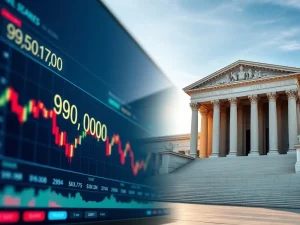S&P 500: Strategy Faces Crucial Hurdles on Path to Elite Stock Market Index

The financial world keenly watches MicroStrategy’s ambition. This prominent Bitcoin holder aims for inclusion in the prestigious S&P 500. Such a move would significantly intertwine the digital asset realm with traditional finance. However, this journey presents several crucial challenges. The path to joining the elite S&P 500 is rigorous, requiring more than just impressive financial metrics.
MicroStrategy’s Strong Position and S&P 500 Aspirations
MicroStrategy, a company synonymous with its substantial Bitcoin holdings, currently commands considerable attention. Analysts widely discuss its potential entry into the S&P 500 stock market index. This benchmark represents the 500 largest U.S. public companies by market capitalization. Market analyst Jeff Walton, for instance, projects a high 91% probability for MicroStrategy’s inclusion. The company indeed moves steadily toward meeting key requirements for this coveted benchmark. Currently, MicroStrategy boasts impressive trading volumes, often reaching several million shares daily. Its market capitalization also exceeds $92 billion, as reported at the time of writing. Furthermore, the company consistently shows positive generally accepted accounting principles (GAAP) net income. Over the last four quarters, this figure surpassed $5.3 billion. These financial metrics generally exceed the standard eligibility criteria for the S&P 500 stock market index. Source: Yahoo Finance. This strong performance underpins much of the optimism surrounding MicroStrategy’s candidacy. The company already holds a spot on the Nasdaq 100, an index tracking the top 100 firms on the tech-focused Nasdaq exchange. However, despite these robust qualifications, a final decision rests with a powerful committee.
Decoding S&P 500 Eligibility: Beyond the Numbers
Inclusion in the S&P 500 requires adherence to strict criteria. These guidelines extend beyond mere financial performance. According to S&P Global methodology, companies must first satisfy several key quantitative metrics:
- Market Capitalization: At least $22.7 billion. This threshold ensures only large, established entities qualify.
- Liquidity Ratio: 0.75 or more. This ratio is calculated by dividing the annual trading volume by the company’s market cap.
- Trading Volume: A minimum of 250,000 shares per month. These liquidity requirements confirm active trading and investor interest.
- GAAP Net Income: The sum of net income over the last four quarters must be positive.
- Recent Profitability: The most recent quarter must also show profitability.
MicroStrategy demonstrably surpasses these quantitative metrics. Its strong financial health and market presence make it a strong contender on paper. However, the path to the stock market index involves more than just numbers. The ultimate decision rests with a distinct body.
The US Index Committee: Gatekeepers of the Elite Stock Market Index
Even when a company meets all financial and liquidity requirements, inclusion in the S&P 500 is not guaranteed. The US Index Committee holds the ultimate authority. This committee comprises ten voting members, each possessing equal voting rights. Their decisions rely on a simple majority vote. The committee undertakes a ‘holistic’ review of prospective candidates. This means they consider factors beyond just the raw data. They evaluate the company’s overall profile, its business model, and its sustainability. For MicroStrategy, this evaluation becomes particularly critical. The committee scrutinizes aspects like the long-term viability of its Bitcoin treasury model. They also assess the company’s stock volatility. Such qualitative factors can significantly influence their final judgment. Thus, while MicroStrategy’s financial standing is robust, the committee’s subjective assessment remains a key hurdle. This committee structure underscores the selective nature of S&P 500 inclusion. It highlights that technical eligibility does not automatically translate into acceptance.
Unique Challenges for MicroStrategy’s Bitcoin Treasury Model
MicroStrategy distinguishes itself as the world’s largest Bitcoin treasury company by holdings. Its corporate treasury currently holds an impressive 636,505 BTC. Publicly traded companies collectively hold over 1 million BTC. This unique business model, however, presents specific challenges for S&P 500 inclusion. A recent Bloomberg report highlighted two primary concerns for the US Index Committee. Firstly, the sustainability of MicroStrategy’s crypto treasury model is under scrutiny. Critics question the long-term stability and inherent risks associated with such significant exposure to a volatile asset. Secondly, the company’s high stock volatility poses another significant hurdle. MicroStrategy’s 30-day price swings average a substantial 96%. This level of fluctuation might concern a committee focused on stability and broad market representation. Traditional index constituents typically exhibit more predictable price movements. The S&P 500 aims for a stable representation of the broader U.S. economy. Consequently, extreme volatility could be viewed as a risk to the index’s integrity. These unique aspects of MicroStrategy’s operation require careful consideration by the committee. Their decision will ultimately reflect their comfort level with integrating a company so deeply tied to digital assets.
Broader Impact for Crypto Companies and Market Integration
The potential inclusion of MicroStrategy in the S&P 500 carries significant implications. It extends far beyond the company itself. This move could attract substantial passive investment flows into the crypto markets. Index funds and ETFs that track the S&P 500 would automatically gain exposure to MicroStrategy. Consequently, they would indirectly invest in its Bitcoin holdings. This increased institutional exposure could further boost crypto asset prices over time. Moreover, it would deepen the intertwining of digital assets with legacy financial markets. The S&P 500 is a weighted stock market index, rebalanced quarterly. It reflects changes in its constituent companies. Integrating a major crypto-centric entity like MicroStrategy would signal a growing acceptance of digital assets. This development could pave the way for other crypto companies to seek similar mainstream recognition. It represents a crucial step in the ongoing maturation of the cryptocurrency ecosystem. The traditional financial world is increasingly acknowledging the permanence and influence of digital assets.
Precedents Set by Other Crypto Companies in the S&P 500
MicroStrategy’s journey follows in the footsteps of other pioneering crypto companies. Coinbase, for example, made history as the first crypto-native company included in the S&P 500 index. It landed on the benchmark in May, marking a significant milestone. This event validated the growing importance of the digital asset industry. Subsequently, Block, a technology company founded by Jack Dorsey, also joined the index in July. Block, with a market capitalization exceeding $46 billion at the time of writing, further solidified crypto’s presence. These inclusions demonstrate a clear trend. The S&P 500 is gradually opening its doors to companies with significant ties to the digital economy. However, both Coinbase and Block operate diverse business models. They are not solely defined by direct Bitcoin treasury holdings in the same way MicroStrategy is. This distinction might influence the committee’s decision. The S&P 500 stock market index has steadily risen since 1990. Source: Yahoo Finance. Their successful integration provides a roadmap. Nevertheless, MicroStrategy’s unique focus presents a different set of considerations for the committee.
The Future Outlook for Strategy and the S&P 500
The coming decision regarding MicroStrategy’s entry into the S&P 500 remains highly anticipated. It holds significant weight for the company and the broader digital asset sector. While MicroStrategy has robustly met the quantitative financial benchmarks, the qualitative assessment by the US Index Committee poses the ultimate test. Factors like stock volatility and the long-term sustainability of its Bitcoin treasury strategy will heavily influence the outcome. A positive decision would not only elevate MicroStrategy’s profile but also further legitimize the role of crypto companies within mainstream finance. It would likely spur further integration and institutional investment into the crypto space. Conversely, a denial could underscore lingering skepticism within traditional finance regarding highly volatile, crypto-centric business models. Regardless of the outcome, MicroStrategy’s journey highlights the evolving landscape. It shows the increasing convergence of traditional stock market index benchmarks and the innovative world of cryptocurrencies. The financial community watches closely, awaiting the committee’s final, pivotal vote.









